Moonraker (film)
Moonraker (1979) is the eleventh spy film in the James Bond series, and the fourth to star Roger Moore as the fictional MI6 agent James Bond. The film, directed by Lewis Gilbert, co-stars Lois Chiles, Michael Lonsdale, Corinne Clery, and Richard Kiel. In the film, Bond is sent to investigate the mysterious theft of a space shuttle, leading him to Hugo Drax, the owner of the shuttle-manufacturing firm. Along with the space scientist Dr. Holly Goodhead, Bond follows the trail of clues from California to Venice, Italy, Rio de Janeiro, and the Amazon rain forest, and finally into outer space in a bid to prevent a plot to wipe out the world population and to re-create humanity with a master race.
Moonraker was intended by its creator Ian Fleming to be turned into a film even before he completed the novel in 1954, since he based the novel on a manuscript he had written even earlier than this. The producers of the James Bond film series had originally intended to do Moonraker in 1973 with Roger Moore making his debut as Bond, but the making of this movie was put on hold and it was finally released in 1979, coinciding with the rise of the science fiction genre in the wake of the Star Wars phenomenon.
Derek Meddings, a long-time contributor to the James Bond series, was nominated for the Academy Award for Best Visual Effects for the special effects used in this movie and its space scenes.
Not taking inflation into account, Moonraker was the highest grossing film of the series[1] until the Pierce Brosnan Bond film GoldenEye (1995). Moonraker earned a total of $210,300,000 worldwide — surpassing the preceding Bond movie The Spy Who Loved Me (1977). Moonraker was also noted for its high production cost for a Bond film, spending almost twice as much money as The Spy Who Loved Me.
Contents |
Plot
A Drax Industries Moonraker space shuttle on loan to the United Kingdom is hijacked in mid-air, destroying the carrier plane. Bond is recalled from Africa to investigate. En route in a small plane, on an unrelated case, Bond is attacked by the pilot (Jean-Pierre Castaldi) and crew (Leila Shenna) and is pushed out of the plane by the mercenary assassin Jaws (Richard Kiel), whom he has met before. Bond survives by stealing a parachute from the pilot in mid-air, whilst Jaws lands on a circus tent. Bond reports to MI6 headquarters in London, and is briefed by M (Bernard Lee) and Q (Desmond Llewelyn) about the hijacking. He begins his investigation at the Drax Industries shuttle-manufacturing complex in southern California.
At Drax Industries, Bond is coldly greeted by the owner of the company, Hugo Drax (Michael Lonsdale), and henchman Chang (Toshiro Suga). Bond meets an astronaut, Dr. Holly Goodhead (Lois Chiles), and survives an assassination attempt via a centrifuge chamber. Bond is later inadvertently aided by Drax's personal pilot, Corinne Dufour (Corinne Clery), as he finds blueprints for a glass vial made in Venice. Bond then foils another attempt on his life, shooting a Drax sniper with a hunting shotgun. When Drax discovers that Dufour assisted Bond in his investigations, Drax fires her, then has his hunting dogs fatally maul her.
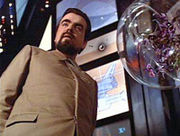
Bond again encounters Goodhead in Venice. He is chased through the canals by Drax's henchmen but his gondola, with the ability to transform into a hovercraft, allows him to escape across the Piazza San Marco in a comic fashion. Bond discovers a secret biological laboratory; by accidentally poisoning the scientists there, he learns that the glass vials are to hold a deadly nerve gas. Chang battles Bond and is killed. During the fight, Bond sees evidence that Drax is moving his operation to Rio de Janeiro. Rejoining Goodhead, he deduces that she is a CIA agent spying on Drax (Bond pointedly notes, "I have friends in low places," an oblique reference to his CIA friend Felix Leiter). They promise to work together (and consummate their alliance), but quickly dispense with the truce. Bond has saved one of the vials he found earlier, as the only evidence of the now-empty laboratory, giving it to M for analysis, who permits him to go to Rio de Janeiro.
In Rio de Janeiro, Bond meets and seduces his Brazilian contact Manuela (Emily Bolton). Drax hires Jaws to finish Chang's job of eliminating Bond. Bond meets Goodhead at the top of Sugarloaf, where they are attacked by Jaws on a cable car. After Jaws' car crashes he is rescued by Dolly (Blanche Ravalec)—a petite blonde girl with super strength—from the rubble, and the two fall in love. Bond and Goodhead are captured by henchmen, but Bond escapes.
Bond reports to a MI6 base in Brazil and learns that the toxin comes from a rare orchid indigenous to the upper catchments of the Amazon jungle. While deadly to humans, it is harmless to all other life. Bond travels the Amazon River looking for Drax's research facility, and soon encounters Jaws and other henchmen again. Bond escapes from his boat just before it hits the Iguacu Falls, and finds Drax's base. Captured by Jaws again, Bond is taken to Drax and witnesses four Moonrakers lifting off. Drax explains that he himself stole the Moonraker because another in the fleet had developed a fault during assembly. Bond is reunited with Goodhead; they escape and successfully pose as pilots on the sixth shuttle. The shuttles dock with Drax's hidden space station.
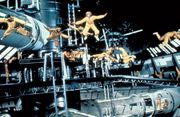
Drax plans to destroy all human life by launching fifty globes containing the toxin into the Earth's atmosphere. Before launching the globes, Drax also transported several dozen young men and women of varying races, which he regarded as genetically perfect, to the space station. They would live there until Earth was safe again for human life; their descendants would be the seed for a "new master race." Bond persuades Jaws and Dolly to switch allegiance by getting Drax to admit that anyone not measuring up to his physical standards would be exterminated (Dolly's glasses and Jaws' metal teeth, as well as their odd heights, being traits that exclude them both) and Jaws starts to brutalise Drax' guards.
Bond and Goodhead disable the radar jammer hiding the station from Earth. The U.S. sends a platoon of Marines in a military shuttle. A laser battle ensues in which Drax's guards as well as his new master race die. During the battle, Bond shoots Drax with a cyanide-tipped dart supplied by Q (fired from a band around his wrist), then pushes Drax into an airlock and ejects him into space.

The space station, heavily damaged in the battle, disintegrates. Jaws helps Bond and Goodhead escape in Drax's space shuttle. In celebration, Jaws opens a champagne bottle and he and Dolly toast (in his only spoken line: "Well, here's to us!"). They too escape the space station as their module breaks away before the station explodes. Before the battle Drax launched three of the globes towards Earth, which Goodhead and Bond destroy from their shuttle. The two make love in space (prompting the memorable exchange between Sir Frederick Gray and Q: "My God, what's Bond doing?" Gray demands, and Q, not looking at the visual monitor but instead reading a tracking scanner, replies, "I think he's attempting re-entry, Sir."). Goodhead has the penultimate line, with "James, take me around the world one more time," to which Bond simply replies, "Why not?" Moonraker 5 then soars past the camera high above the Earth and out of view.
Cast
- Roger Moore as James Bond: An MI6 agent assigned to look into the theft of a shuttle from the "Moonraker" space programme.
- Lois Chiles as Holly Goodhead: A CIA agent who joins Bond and flies with him to Drax's space station.
- Michael Lonsdale as Sir Hugo Drax: Main antagonist. An industrialist who plans to poison all humans on earth and establish a civilization in space.
- Richard Kiel as Jaws: A henchman, afflicted by giantism and with a set of stainless steel teeth, whom Drax hires as a replacement for Chang. He helps Bond defeat Drax after learning that hormonally abnormal humans would be killed by the latter.
- Toshiro Suga as Chang: Drax's bodyguard, skilled at martial arts.
- Corinne Clery as Corinne Dufour: Drax's personal pilot, killed by Drax's doberman pinschers after she inadvertently aids Bond.
- Bernard Lee as M: The head of MI6. This was Bernard Lee's last appearance as M, as he died just just before release of For Your Eyes Only.
- Geoffrey Keen as Frederick Gray: The British Minister of Defence.
- Desmond Llewelyn as Q: MI6's "quartermaster" who supplies Bond with multi-purpose vehicles and gadgets useful for the latter's mission.
- Lois Maxwell as Miss Moneypenny: M's secretary.
- Emily Bolton as Manuela: Bond's local contact in Rio.
- Michael Marshall as Colonel Scott: U.S. Space Marines commander who leads the assault on Drax's space station.
- Walter Gotell as General Gogol: The head of the KGB.
- Blanche Ravalec as Dolly: Jaws' girlfriend.
Production
The end credits for the previous Bond film, The Spy Who Loved Me, said, "James Bond will return in For Your Eyes Only"; however, the producers chose the novel Moonraker as the basis for the next film,[2] following the box office success of the 1977 space-themed film Star Wars. For Your Eyes Only was subsequently delayed and ended up following Moonraker in 1981.[3]
Script
Ian Fleming had originally intended the novel, published in 1954, to be made into a film even before he began writing it and was based on an original manuscript of a screenplay which had been on his mind for years.[4] In 1955, the film rights to Moonraker were initially sold to John Payne of the Rank Organisation for £10,000 (£195,291 present value), paying a $1000 a month option for nine months. Payne was the first person interested in making the novels into a film series, but later rejected the idea based on the fact it wouldn't be possible for him to obtain the rights to the entire 007 series. In spring 1959, due to on-going difficulties, Fleming eventually bought back the rights for his novels, shortly before selling them to Harry Saltzman[5]
However, as with several previous Bond films, the story from Fleming's novel is almost entirely dispensed with, and little more than the name of Hugo Drax was used in film, in favour of a film more in keeping with the era of science fiction. The 2002 Bond film Die Another Day makes further use of some ideas and character names from the novel. Tom Mankiewicz had written a full screenplay of Moonraker that was eventually partly discarded. According to Mankiewicz footage shot at Drax's lairs was considerably more detailed than the edited result in the final version. The crew had shot a scene with Drax meeting his co-financiers in his jungle lair and they used the same chamber room below the space shuttle launch pad that Bond and Goodhead eventually escape from. This scene was shot but later cut out.[6] Another scene involving Bond and Goodhead in a meditation room aboard Drax's space station, was shot but never used in the final film. However, press stills were released of the scene which featured on Topps trading cards in 1979 as was a theatrical trailer which featured Bond punching Jaws in the face aboard the space station, neither of which featured in the complete film.[6] Some scenes from Mankiewicz's script were later used in subsequent films, including the Acrostar Jet sequence used in the pre-credit sequence for Octopussy, and the Eiffel Tower scene in A View to a Kill.
In March 2004, an Internet hoax stated rumours about a lost 1956 version of Moonraker by Orson Welles, and a James Bond web site repeated it on April Fool's Day in 2004 as a hoax. Supposedly, this recently discovered lost film was 40 minutes of raw footage with Dirk Bogarde as Bond, Welles as Drax, and Peter Lorre as Drax's henchman.[7] A film poster was created displaying the actors and the title of the film.
Novelization
The screenplay of Moonraker differed so much from Ian Fleming's novel that EON Productions and Glidrose Publications authorised the film's screenwriter, Christopher Wood to write his second novelization based upon the film. It was named James Bond and Moonraker to avoid confusion with Fleming's original novel Moonraker. It was released in 1979, in the aftermath of the film's release.[8]
Casting
The role of the villain, Hugo Drax, was originally offered to James Mason.[9] However well-established French actor Michael Lonsdale was cast as Drax, partly due to his fluency in English, and Corinne Clery for the part of Corinne Dufour, given that the film was produced in France. American actress Lois Chiles had originally been offered the role of Anya Amasova in The Spy Who Loved Me (1977), but had turned down the part when she decided to take temporary retirement. Chiles was cast as Holly Goodhead by chance, when she was given the seat next to Lewis Gilbert on a flight and he believed she would be ideal for the role as the CIA scientist.[2] Drax's henchman Chang, played by Japanese aikido instructor Toshiro Suga, was recommended for the role by executive producer Michael G. Wilson, who was one of his pupils.[2] In Moonraker, Wilson also continued a tradition in the Bond films he started in the film Goldfinger where he has a small cameo role. He appears twice in the film, first as a tourist outside the Venini Glass shop and museum in Venice, then at the end of the film as a technician in Drax's control room.
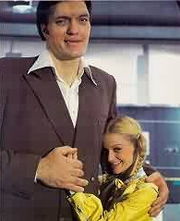
The Jaws character, played by Richard Kiel makes a return, although in Moonraker the role is played more for comedic effect than in The Spy Who Loved Me. Jaws was intended to be a villain against Bond to the bitter end, but director Lewis Gilbert stated on the DVD documentary that he received so much fan mail from small children saying "Why can't Jaws be a goodie not a baddie", that as a result he was persuaded to make Jaws gradually become Bond's ally at the end of the film.[2]
Diminutive French actress Blanche Ravalec, who had recently begun her career with minor roles in French films such as Michel Lang's Holiday Hotel (1978) and Claude Sautet's Academy Award for Best Foreign Language Film nominee, A Simple Story (1978), was cast as the bespectacled Dolly, the girlfriend of Jaws. Originally, the producers were dubious about whether the audience would accept the height difference between them, and only made their decision once they were informed by Richard Kiel that his real-life wife was of the same height.[9] Lois Maxwell's 22 year old daughter, Melinda Maxwell, was also cast as one of the "perfect" human specimens from Drax's master race.[4]
Filming and effects
Production began on August 14, 1978. The main shooting was switched from the usual 007 Stage at the Pinewood Studios to France, due to high taxation in England at the time. Only the cable car interiors and space battle exteriors were filmed at Pinewood. The massive sets of Moonraker designed by Ken Adam were the largest ever constructed in France and required more than 222,000 man-hours to construct (roughly 1000 hours by each of the crew on average).[2] They were shot at three of France's largest film studios in Epinay and Boulogne-Billancourt.[4] 220 technicians used 100 tonnes of metal, two tonnes of nails and 10,000 feet of wood to build the three-story space station set at Eponay Studios.[4] The elaborate space set for Moonraker holds the world record for having the largest number of zero gravity wires in one scene.[2] The Venetian glass museum and fight between Bond and Chang was shot at Boulogne Studios in a building which had once been a World War II Luftwaffe aircraft factory during Germany's occupation of France.[4] The scene in the Venice glass museum and warehouse holds the record for the largest amount of break-away sugar glass used in a single scene.[2]
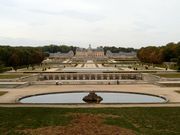
Drax's mansion, set in California, was actually filmed at the Château de Vaux-le-Vicomte, about 55 kilometres (34 mi) southeast of Paris, for the exteriors and Grand Salon. The remaining interiors, including some of the scenes with Corinne Defour and the drawing room, were filmed at the Château de Guermantes.[2]
Much of the film was shot in the cities of London, Paris, Venice, Palmdale, Calif., and Rio de Janeiro. The production team had considered India and Nepal as a location in the film but on arriving at those places to investigate, they found that it was inconceivable to write them into the script, particularly with time restrictions to do so.[2] They decided on Rio de Janeiro, Brazil, relatively early on, a city that Cubby Broccoli had visited on vacation, and a team was sent to that city in early 1978 to capture initial footage from the Carnaval festival which featured in the film.[2]
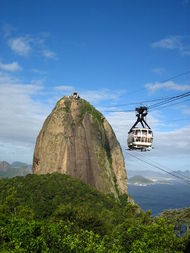
At the Rio de Janeiro location, many months later, Roger Moore arrived several days later than scheduled for shooting due to recurrent health problems and an attack of kidney stones that he had suffered while in France.[2] After arriving in Rio de Janeiro, Moore was immediately whisked off the plane and went straight to hair and make-up work, before reboarding the plane, to film the sequence with him arriving as James Bond in the film. Sugarloaf Mountain was a prominent location in the film, and during filming of the cable car sequence in which Bond and Goodhead are attacked by Jaws during mid-air transportation high above Rio de Janeiro, the stuntman Richard Graydon slipped and narrowly avoided falling to his death.[2] For the scene in which Jaws bites into the steel tramway cable with his teeth, the cable was actually made of liquorice, although Richard Kiel was still required to use his steel dentures.[4]
Iguazu Falls was a natural location depicted in the film, although as stated by "Q" in the film, the falls were intended to be located somewhere in the upper basin of the Amazon River rather than where the falls are actually located in the south of Brazil. The second unit had originally planned on sending an actual boat over the falls.[2] However on attempting to release it, the boat became firmly embedded on rocks near the edge. Despite a dangerous attempt by helicopter and rope ladder to retrieve it, the plan had to be abandoned, forcing the second unit to use a miniature at Pinewood instead.[2] The exterior of Drax's pyramid headquarters in the Amazon rain forest near the falls was actually filmed at the Tikal Mayan ruins in Guatemala.[4] The interior of the pyramid, however, was designed by Ken Adam at Pinewood studio in which he purposefully used a shiny coating to make the walls look plastic and false.[2] All of the space center scenes were shot at the Vehicle Assembly Building of the Kennedy Space Center, Florida, although some of the earlier scenes of the Moonraker assembly plant had been filmed on location at the Rockwell International manufacturing plant in Palmdale, California.
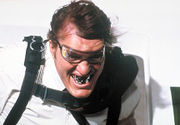
The early scene involving Bond and Jaws in which Bond is pushed out of the aircraft without a parachute took weeks of planning and preparation. The skydiving sequence was coordinated by Don Calvedt under the supervision of second unit director John Glen.[2] Stuntman Jake Lombard was hired to double for Bond, who would later pose as Moore's double in films such as Octopussy and for Necros in The Living Daylights. B. J. Worth, who played the stunt double of Jaws, would also later become a consistent member of the stunt team for aerial sequences throughout the 1980s, into Timothy Dalton's films such as The Living Daylights.[2] Members of the U.S. championship skydiving team aided the stunt team with the planning and the team's master rigger designed a 1-inch-thick (25 mm) parachute pack that could be concealed beneath the suit to give the impression of the missing parachute.[2] When the stunt men opened their parachutes at the end of every shoot, custom-sewn velcro costume seams would separate to allow the hidden parachutes to open.[4] The skydiver cinematographer used a lightweight Panavision camera, bought from an old pawn shop in Paris, which he had adapted, and attached to his helmet to shoot the entire sequence.[2] The scene took a total of 88 skydives by the stuntmen to complete it.[2]
For the scene involving the opening of the musical electronic laboratory door lock in Venice, producer Albert R. Broccoli requested special permission from director Steven Spielberg to use the five-note melody from his film Close Encounters of the Third Kind (1977). In 1985, Broccoli would return the favor by fulfilling Spielberg's request to use the James Bond theme music for a scene in his film, The Goonies (1985).
Music
Moonraker was the third of the three Bond films for which the theme song was performed by Shirley Bassey (following Goldfinger and Diamonds are Forever). Kate Bush and Frank Sinatra were both considered for the vocals, before Johnny Mathis was approached and offered the opportunity. However Mathis, despite having started recording with Barry, was unable to complete the project, leaving producers to offer the song to Ms. Bassey just weeks before the premiere date in England.[10] Bassey made the recordings with very short notice and as a result, she never regarded the song 'as her own' as she had never had the chance to perform it in full or promote it first.[10] The film uses two versions of the title theme song, a ballad version heard over the main titles, and a disco version over the closing titles. Confusingly, the United Artists single release labelled the tracks on the 7" single as "Moonraker (Main Title)" for the version used to close the film and "Moonraker (End Title)" for the track that opened the film.[11] The song made little impact on the charts, reaching 159, partly attributed to Bassey's failure to promote the single, given the last-minute decision to quickly record it to meet the schedule.[12]
The soundtrack of Moonraker was composed by John Barry and recorded in Paris, again, as with production, marking a turning point away from the English location at CTS Studios in London. The score also marked a turning point in John Barry's output, abandoning the Kentonesque brass of his earlier Bond scores and instead scoring the film with slow, rich string passages - a trend which Barry would continue in the 1980s with scores such as Out of Africa and Somewhere in Time.[13] For Moonraker, Barry uses for the first time since Diamonds Are Forever (1971) a piece of music called "007" (on track 7), the secondary Bond theme composed by Barry which was introduced in From Russia with Love during Bond's escape with the Lektor. Barry also made use of classical music passages in the film. For the scene where Bond visits Drax in his chateau, Drax plays Frédéric Chopin's Prelude no. 15 in D-flat major (op. 28), "Raindrop" on his grand piano (although he plays in the key of D major).[11] Tritsch-Tratsch-Polka by Johann Strauss II was featured during the hovercraft scene on the Piazza San Marco in Venice,[11] and Tchaikovsky's "Romeo and Juliet Overture" was used for the scenes in Brazil in which Jaws meets Dolly following his accident.[11] Other passages pay homage to earlier films including Richard Strauss's Also Sprach Zarathustra (op. 30),[11] associated with 2001: A Space Odyssey) with the hunting horn playing its distinctive first three notes, Elmer Bernstein's theme from The Magnificent Seven when Bond appears on horseback in gaucho clothing at MI6 headquarters in Brazil, and the alien-contacting theme from Close Encounters of the Third Kind as the key-code for a security door as mentioned previously.[11]
Finally in 2005, Bassey sang the song for the first time outside James Bond on stage as part of a medley of her three Bond title songs.[10] An instrumental strings version of the title theme was used in 2007 tourism commercials for the Dominican Republic.
Release
| Country | Date of release |
|---|---|
| Premiere: 26 June 1979 | |
| 29 June | |
| 12 July | |
| 18 July | |
| 26 July | |
| 1 August | |
| 13 August | |
| 17 August | |
| 17 August | |
| 18 August | |
| 27 August | |
| 31 August | |
| 31 August | |
| 9 September | |
| 27 September | |
| 10 October | |
| 8 December | |
| 11 December |
Moonraker premiered on June 26, 1979, in the United Kingdom, it and premiered three days later in the United States of America, grossing $70,308,099 in the UK. It opened in 788 theaters, grossing a total of $210,308,099 worldwide.[14] On the mainland of Europe, the most common month of release was in August 1979, opening in the Scandinavian countries of Denmark, Finland, Norway, and Sweden between August 13 and August 18. Moonraker was released in Kenya on August 27. Given that the film was produced largely in France, and it involved some notable French actors, the French premiere for the film was relatively late, released in that country on October 10, 1979.
Video releases
Moonraker was one of the first James Bond Movies released on VHS, and one of the first James Bond Movies released on DVD. In 1998 a barebones THX edition was released. Moonraker was released with a Dolby Digital 5.1 mix on the MGM Special Edition in 2000, but it was re-released in 2006 as an Ultimate Edition with enhanced footage. The 42-minute documentary Inside Moonraker on the special effects and stuntwork was carried over from the original release, as was the 18 minute The Men Behind the Mayhem featuring director Lewis Gilbert, executive and associate producers Michael G. Wilson and William P. Cartlidge and writer Christopher Wood, relating memories of the production. The Ultimate Edition comes with several commentaries, one which features Roger Moore, which had been recently recorded for the release.[15]
The second disc of the Ultimate Edition DVD opens with an 11-minute footage of set designer Ken Adam's productions, including home interviews with him and an exploration of Eon Productions locations and sets.[15] Other features include Michael G. Wilson introducing interviews with the members of the cast and crew and an archive 12-minute feature, 007 in Rio, which covers the production team in Rio de Janeiro but takes a more general analysis of behind the scenes in the overall film.[15] There is also brief storyboard coverage including four short storyboard sequences and test footage, which includes coverage of the circus landing, the cable car scene and the skydiving scene.
Moonraker was released on Blu-ray Disc in March 2009. It includes the same special features as the Ultimate Edition DVD, some of which are now presented in high definition.
Reception
Derek Meddings, a long-time contributor to the James Bond series, received an Academy Award for Best Visual Effects nomination for the special effects used in the film and the space scenes. However, although the film was widely praised for its special effects and advancement in technology and production sets, the film is often considered by critics and an element of James Bond fans as one of the lesser films in the series, largely due to the extent of the plot which takes James Bond into space, some of ploys used in the film for comedic effect, and its extended dialogue. Reviews have generally been balanced between criticizing the far-fetched nature of the plot, and comments that have reflected that they enjoyed the film for this very reason. Other critics continued to illustrate their disapproval for the attempts at comedy in this film, with some critics mocking Jaws's "flapping his wings" and circus landing site during the skydive sequence and others describing the comedic aspects of the film as cheesy. Critic Nicholas Sylvain said of the movie "Moonraker seems to have more than its share of little flaws and annoyances which begin right from the opening pre-credit sequence. The sheer idiocy (and impossibility) of having a fully-fueled shuttle on the back of the Boeing during the trans-Atlantic crossing should be evident, and later in the film, the whole Jaws-falls-in-love and becomes a "good guy" routine leaves me rather cold, and provides far too much cheesy comedy moments, as does the gondola driving through the square scene."[16]

In his review of Moonraker in 1979, the Chicago Sun-Times film critic Roger Ebert, while clearly expressing his approval of the advanced special effects and Ken Adam's extravagant production sets, criticized the pace in which the locations of the film evolved, remarking that, "it's so jammed with faraway places and science fiction special effects that Bond has to move at a trot just to make it into all the scenes".[17]Christopher Null of Filmcritic.com said of the film; "Most rational observers agree that Moonraker is without a doubt the most absurd James Bond movie, definitely of the Roger Moore era and possibly of all time".[18] However, while he criticized the extravagance of the plot and action sequences, he believed that this added to the enjoyment of the film, and particularly approved of the remark "I think he's attempting re-entry!" by "Q" during Bond and Goodhead's orbiting of the Earth which he described as "featuring what might be the best double entendre ever".[18]
Reviewing Moonraker, cult film critic Danny Peary wrote that “The worst James Bond film to date has Roger Moore walking through the paces for his hefty paycheck and giving way to his double for a series of unimaginative action scenes and "humorous" chases. There’s little suspense and the humor falls flat. Not only is Jaws so pacified by love that he becomes a good guy, but the filmmakers also have the gall to set the finale in outer space and stage a battle right out of Star Wars.”[19]
However, other reviews of Moonraker have expressed that the film is one of Moore's stronger films as James Bond. James Berardinelli of Reelviews.net for instance remarked that, "the solid special effects, well-executed action sequences, and a strict reliance upon the "Bond Formula" keep this film among Moore's better entries."[20] Despite criticism about the far-fetched nature of the plot, Web sites such as Rotten Tomatoes have awarded the film a 64% "fresh" rating (100% with Top Critics).
Aside from being nominated for an Academy Award for Best Visual Effects, the film, given its greater attention to the science fiction genre than the average James Bond film, received attention from the Academy of Science Fiction, Fantasy & Horror Films and was nominated for several Saturn Awards in 1980. The nominees were for Best Science Fiction Film, Best Special Effects, and Best Supporting Actor (Richard Kiel). The DVD of the film was later nominated in 2004 for the Golden Satellite Award Best Classic DVD Release. Moonraker won the Golden Screen Award in Germany in 1980.
The exaggerated nature of the plot and space station sequence has seen the film parodied on numerous occasions. Of note is the Austin Powers spoof film The Spy Who Shagged Me (1999) which whilst a parody of other James Bond films, pays reference to Moonraker by Dr. Evil's lair in space. The scene in which Drax is shot by the cyanide dart and ousted into space is parodied by Powers's ejection of Dr. Evil's clone Mini-Me into outer space in the same way.
Broadcast television versions
The version that has aired on Italian television is heavily edited to fit into the scheduling. Not only that, but this version also alters the plot of the film significantly, particularly in the opening skydiving sequence. More specifically, after stealing the pilot's parachute, Bond clips it shut and (the end result being) the scene involving Jaws is completely gone. Instead, the film cuts from the pilot screaming to the shot of someone (Jaws in the original theatrical version) falling onto the circus big top, making it look as if this is the pilot. Also, the scene with Corinne Dufour being torn apart by dogs is gone. Instead, after she shows Bond the hidden safe, she is never seen again. Meanwhile, Drax only appears in the Cucumber Sandwiches scene before we see him chastising Bond for breaking up the fight with the snake.
On ABC's Bond Picture Show there is a digitally altered scene involving Bond being lured to Drax's hidden pyramid base by one of Drax's beauties. In the original theatrical version, as Bond is following her, a shot of her walking reveals some brief nudity as she has no clothing underneath her top. In the ABC version, the lady now has clothing underneath her top.
References
- ↑ $70,308,099.00 in 1979 had about the same buying power as $224,268,296.47 in 2010.
- ↑ 2.00 2.01 2.02 2.03 2.04 2.05 2.06 2.07 2.08 2.09 2.10 2.11 2.12 2.13 2.14 2.15 2.16 2.17 2.18 2.19 (DVD) Inside Moonraker. MGM.
- ↑ (DVD) For Your Eyes Only Special Edition, Region 2. MGM. 1981.
- ↑ 4.0 4.1 4.2 4.3 4.4 4.5 4.6 4.7 Moonraker Special Edition, Region 2 booklet. 2000.
- ↑ "Biography - Harry Saltzman". Mi6.co.uk. February 18, 2005. http://mi6.co.uk/sections/articles/biography_harry_saltzman.php3. Retrieved November 11, 2008.
- ↑ 6.0 6.1 "Moonraker:Cut Scenes & Alternate Versions". Mi6.co.uk. http://www.mi6.co.uk/sections/movies/mr.php3. Retrieved October 3, 2008.
- ↑ "Moonraker: The "Forgotten" 1956 Film Version?". Commanderbond.net. April 7, 2004. http://www.commanderbond.net/Public/Stories/2323-1.shtml. Retrieved October 3, 2008.
- ↑ "Christopher Wood Interview". Mi6.co.uk. February 6, 2005. http://www.mi6.co.uk/sections/articles/interview_christopher_wood.php3. Retrieved November 11, 2008.
- ↑ 9.0 9.1 "Moonraker:Trivia". Mi6.co.uk. http://www.mi6.co.uk/sections/movies/mr.php3. Retrieved October 3, 2008.
- ↑ 10.0 10.1 10.2 "The Filming of Another Audience With Shirley Bassey". Bassey.co.uk. http://www.bassey.co.uk/blog/shirley_bassey/2006_03_12_peggyblog.html. Retrieved November 11, 2008.
- ↑ 11.0 11.1 11.2 11.3 11.4 11.5 (DVD) Moonraker Special Edition, Region 2. MGM. 2000.
- ↑ "Moonraker:Music written by John Barry and lyrics by Hal David". Songs of Shirley Bassey. http://www.songsofshirleybassey.co.uk/song/sng79009.html. Retrieved November 11, 2008.
- ↑ "Dances With Wolves". Filmtracks.com. http://www.filmtracks.com/titles/dances_wolves.html. Retrieved November 11, 2008.
- ↑ "Moonraker (1979)". Box Office Mojo. http://www.boxofficemojo.com/movies/?page=main&id=moonraker.htm. Retrieved June 10, 2008.
- ↑ 15.0 15.1 15.2 "Moonraker (Ulimate DVD Edition)". DVD Times. 2006. http://www.dvdtimes.co.uk/content.php?contentid=62208. Retrieved October 3, 2008.
- ↑ Sylvain, Nick. "Verdict on Moonraker". DVD Verdict. http://www.dvdverdict.com/reviews/bondmoon.php. Retrieved October 5, 2007.
- ↑ Ebert, Roger. "Moonraker". Chicago Sun-Times. http://rogerebert.suntimes.com/apps/pbcs.dll/article?AID=/19790101/REVIEWS/41008002/1023. Retrieved October 3, 2008.
- ↑ 18.0 18.1 Null, Christopher (2005). "Moonraker". Filmcritic.com. http://www.filmcritic.com/misc/emporium.nsf/84dbbfa4d710144986256c290016f76e/4417de46f8fb4c618825709a006bcd63?OpenDocument. Retrieved October 3,2008.
- ↑ Danny Peary, Guide for the Film Fanatic (Simon & Schuster, 1986) p.281
- ↑ "Moonraker (1979)". Rottentomatoes.com. http://www.rottentomatoes.com/m/1014217-moonraker/. Retrieved October 5, 2007.
External links
- Moonraker at the Internet Movie Database
- Moonraker at Allmovie
- Moonraker at Rotten Tomatoes
- Moonraker at Box Office Mojo
- MGM's official site for Moonraker
| Preceded by The Spy Who Loved Me |
James Bond Films 1979 |
Succeeded by For Your Eyes Only |
|
|||||||||||||||||||||||||
|
|||||||||||||||||||||||